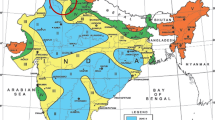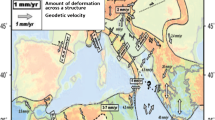Abstract
Nuclear power plants (NPP) play increasing role in power supply worldwide. To meet demands of the human society, the NPPs have to be built where the energy is required, including seismoactive regions. Therefore, the safety issues related to reliable assessment of earthquake hazard are crucial. The basic concept of seismic hazard assessment is that the seismic regime is stable, i.e. the prediction of future hazard is defined by the past observations. As a consequence, huge efforts are spent to get seismic history as long as possible. Palaeoearthquake studies can provide information on past earthquakes occurred 15,000–20,000 years before present. But for such time-intervals, the basic concept might be wrong, at least for certain regions. For example, for regions where earthquakes in the past were generated due to post-glacial processes — the geodynamic situation there today is different now. So, the time-arrow of geodynamic evolution has to be somehow incorporated in hazard assessment.
In hazard assessment very rare occurrences are taken into account now: such as having 10−5 or 10−6 annual frequencies of occurrence (return period 100,000–1,000,000 years). This demands very accurate interpretation of the nature of past seismic event. In the paper, some examples are given when effects similar to earthquakes can be caused by other natural phenomena.
Similar content being viewed by others
References
Aven, T. (2016) On the use of conservatism in risk assessments. Reliability Engineering & System Safety, v.146, pp.33–38.
Brandes, Ch., Steffen, H., Sandersen, P.B.E., Wu, P., Winsemann, J. (2018) Glacially induced faulting along the NW segment of the Sorgenfrei-Tornquist Zone, northern Denmark: Implications for neotectonics and Lateglacial fault-bound basin formation. Quaternary Sci. Rev., v.189, pp.149–168.
IAEA (2010) Seismic Hazards in Site Evaluation for Nuclear Installations. Specific Safety Guide SSG-9. International Atomic Energy Agency, Vienna.
Leonard, M. (2010) Earthquake fault scaling: Self-consistent relating of rupture length, width, average displacement, and moment release. Bull. Seismol. Soc. Amer., v.100(5A), pp.1971–1988.
Leonard, M. (2014) Self-Consistent Earthquake Fault-Scaling Relations: Update and Extension to Stable Continental Strike-Slip Faults. Bull. Seismol. Soc. Amer., v.104(6), pp.2953–2965. doi: https://doi.org/10.1785/0120140087.
Phillips, E.R. (2018) Glacitectonics. In: John Menzies, Jaap J.M. van der Meer (Eds.) Past Glacial Environments. Elsevier, Second Edition, Chapter 13, pp.467–502. doi:https://doi.org/10.1016/B978-0-08-100524-8.00014-2.
Pisarska-Jamroiy, M., Belzyt, S., Bitinas, A., Jusienë, A., Woronko, B. (2019) Seismic shocks, periglacial conditions and glaciotectonics as causes of the deformation of a Pleistocene meandering river succession in central Lithuania. Baltica, v.32(1), pp.63–77. doi: 5200/baltica.2019.1.6
Tatevossian, R. and Mokrushina, N. (2019) On the Nature of Seismic Phenomena in Platform Areas: A Case Study of Belarus. Seismic Instruments, v.55(3), pp.255–270.
Topal, S. and Özkul, M. (2014) Soft-Sediment Deformation Structures Interpreted as Seismites in the Kolankaya Formation, Denizli Basin (SW Turkey). The Scientific World Jour., v., Article ID 352654, 13 pages. doi:https://doi.org/10.1155/2014/352654
Wells, D.L. and Coppersmith, K.J. (1994) New empirical relationships among magnitude, rupture length, rupture width, rupture area, and surface displacement. Bull. Seismol. Soc. Amer., v.84(4), pp.974–1002.
Acknowledgements
The study was carried out under the state task of the Schmidt Institute of Physics of the Earth, Russian Academy of Sciences.
Author information
Authors and Affiliations
Corresponding author
Rights and permissions
About this article
Cite this article
Tatevossian, R. Seismic Hazard Assessment for Nuclear Power Plants: How to Cope with Rare Events?. J Geol Soc India 97, 1504–1507 (2021). https://doi.org/10.1007/s12594-021-1905-x
Received:
Accepted:
Published:
Issue Date:
DOI: https://doi.org/10.1007/s12594-021-1905-x




